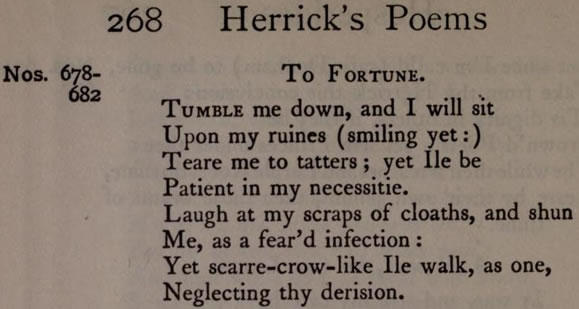Podcast: Play in new window | Download
In this episode I talk about emoticons or “pictorial representation of a facial expression using punctuation or other keyboard characters”. Emoticon is short for “emotion icon” and first appeared in 1994 [source].
Earlier sightings of possible emoticons in the wild include a possibly smiley face in 1648 in To Fortune, a poem by Robert Herrick, an English poet, that appears in The Hesperides & Noble Numbers, a collection of his poems. This appears in only one of the online editions of his work though:

In a transcription of a speech by Abraham Lincoln published in The New York Times on 7th August 1862, a possible wink emoticon appears: (applause and laughter ;), although it is debated whether this was an emoticon or just punctuation.
In 1881 the satirical magazine Puck published examples of typographical art using puncutation marks to express joy, melancholy, indifference or astonishment.

In 1912 Ambrose Bierce, an American writer and journalist, suggested uses a bracket ‿ to represent a smile, and called it the snigger point or note of cachination [kakɪˈneɪʃ(ə)n] (loud, convulsive laughter).
Other writers proposed ways to use punctuation marks to represent faces, including Alan Gregg, who wrote in a 1936 article in the Harvard Lampoon that (-) could represent a smile, (—) a laughing smile, (#) a frown and (*) a wink.
First smiley emoticons created by Scott Fahlman, Professor Emeritus at Carnegie Mellon University’s Language Technologies Institute and Computer Science Department, in 19th September 1982:
![]()
In Japan, for example, a type of emoticon known as kaomoji (顔文字) or ‘face characters’ developed in the 1980s combining punctuation marks and Japanese katakana glyphs to make horizontal faces, such ass (*_*), (^.^), {^_^} (T_T) & (^ム^).
In Korean combinations of hangeul letters (jamo) and punctuation marks are used: ㅇㅅㅇ, ㅇㅂㅇ, ㅇㅁㅇ, ^오^.
More information about punctuation
https://en.wikipedia.org/wiki/Emoticon
http://scihi.org/scott-fahlman-emoticons/
Music featured in this episode
You can also listen to this podcast on: Apple Podcasts, Stitcher, TuneIn, Podchaser, PlayerFM, podtail and or via this RSS feed.
If you would like to support this podcast, you can make a donation via PayPal or Patreon, or contribute to Omniglot in other ways.
